SO, LET'S GET STARTED IN DECIPHERING THE CODED POSITIONS
IN AND AROUND DURRINGTON WALLS HENGE.
Durrington Wall's Henge, like it's smaller counterpart, Stonehenge,
was built to be slightly elliptical. A circle that will fully encompass
the exterior perimeter of the site, while skimming the most extreme outer
limits of the embankments. is 1701-feet in diameter. An inner circle that
best describes the largest across-site dimension is 1417.5-feet in diameter.
Although the embankments are elliptical, rather than perfectly round, from
these two precisely executed, coded ovals, the exact centre of Durrington
Walls Henge can be determined to reside at or very near to: Latitude 51.192489
Longitude -1.786540.
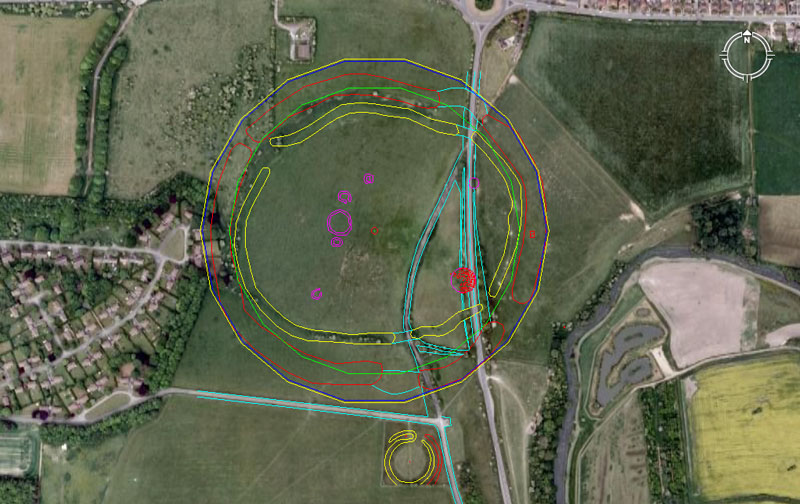
A yellow circle of 1701-feet best describes the outer
limits of Durrington Walls Henge, whereas the inner dimension (green circle)
is best described as 1417.5-feet. Both of these values are very strong lunar
codes that recur often on code-bearing sites across the world. For example:
-
The Octagon geometric earth
embankment mound complex of Newark, Ohio measures 2835-feet
internally, from the SSE alcove of the circle embankment,
through the Avenue, to the extremity of the site at the NNW gate. That distance
is exactly twice the largest external diameter between embankment outer
edges of the Durrington Walls Henge.
- The Khafre Pyramid of Egypt
(708.75-feet or (15/16ths) the base length of the Great Pyramid (756-feet)
measures 1412.5-feet per two sides. That distance is exactly the same as the
internal diameter of Durrington Walls Henge and one complete circuit of the
the Khafre Pyramid @ 2835-feet is the internal measurement of the Octagon
of Newark, Ohio.
- From the obelisk at Avebury Henge
a line runs southwards and touches down on the line of obelisk boulders adjacent
to the doorway into West Kennet Longbarrow.
The intended or coded distance for this length was very definitely 7087.5'
(10 X the design length of Khafre Pyramid). The distance is fully verified
by the return angle back to the obelisk at Avebury Henge, which is 354.375°
(354.375 - 3543/8-days = the lunar year and this value in feet is half the
length of Khafre Pyramid ... 354.375 X 2 = 708.75).
- It appears evident that the astronomer-surveyors of Durrington Walls Henge
used a prominent landmark 17010-feet distant as their accurate outer marker
designating precise due East. From the centre of the site the due East line
resolved in a "V" cleft, situated between two precisely placed or
shaped mound-hillocks 17010-feet from the henge centre.
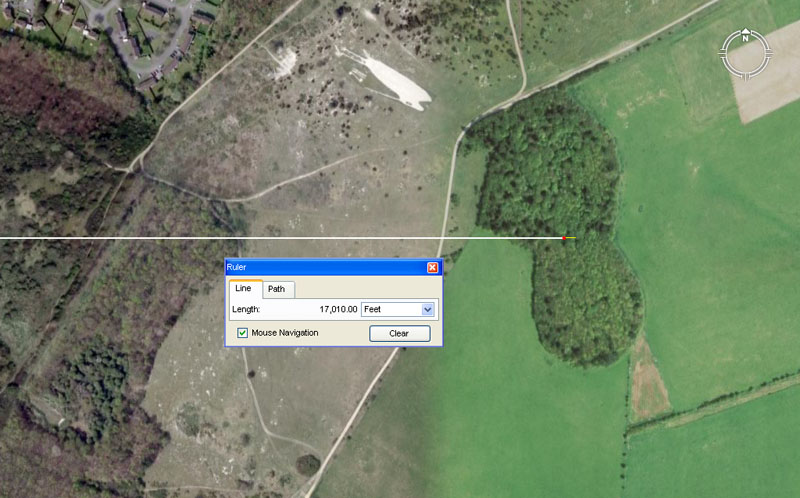
From the epicentre of Durrington Walls Henge the due East
sight-line resolves in the "V" saddle between mounds @ a distance
of 17010-feet. One assumes that this very precise fix onto an outer-marker could
be seen from the henge. Such a direct line of sight would mean that ancient
alidade sighting rules (theodolites) could then be set to accurately determine
the angle to any landmark or purpose-placed, outlying mound within 360-degrees
of vista.
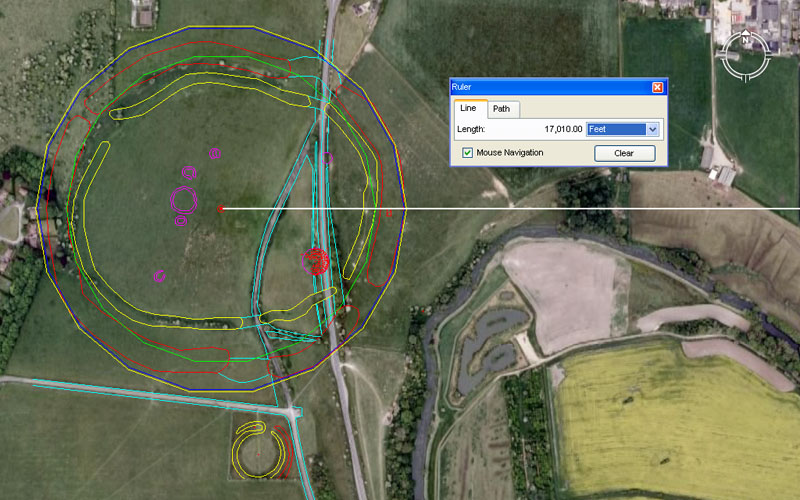
From the centre of Durrington Walls Henge one looked due
East, over a surveying marker structure erected on the eastern embankment crest
to the outer marker situated exactly 3.24 Greek miles away. From this sight-line,
all theodolite devices could be accurately set.
But that wasn't the preeminent surveying fix point.
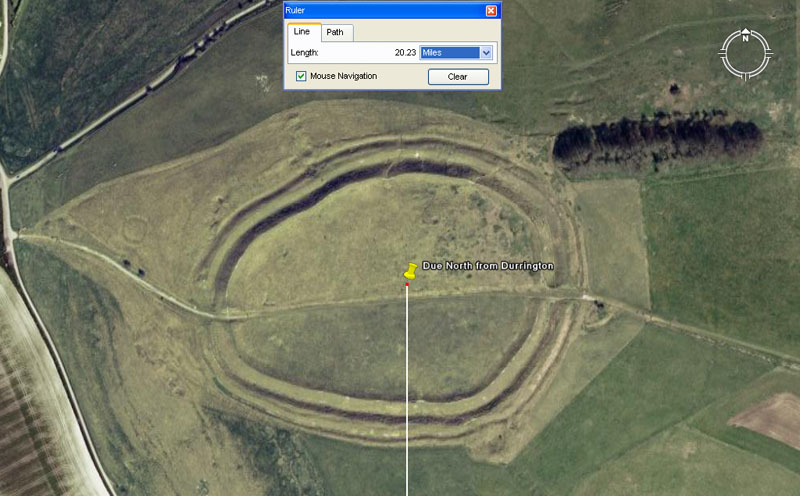
Barbury Castle, considered to be a hillfort from the Iron
Age, sits perfectly due North (360-degrees), centre to centre, from Durrington
Walls Henge. This hillfort is located on the high Ridgeway, with commanding
views and wide vistas in all directions. Due to its very elevated position it
appears very likely that this distant hill crown was visible*, in clear weather
conditions, from Durrington Walls Henge and constituted the outer-marker for
precise fixes onto due North. The surveying evidence would suggest
that the architectural and surveying choice of epicentre position for constructing
Durrington Walls Henge was fully contingent upon the crown of this high northern
hill near Swindon.
*Footnote: This researcher has sent
a series of email requests to English Heritage, The National Trust and the Durrington
Borough Council, asking if it is possible to see Barbury Castle Hill crown (in
perfect weather conditions) from Durrington Walls Henge, as well as from other
mound and henge locations (Stonehenge?) in the vicinity, but no answer has been
forthcoming. If a kind, local resident can answer the question, or, better still,
supply a photograph of Barbury Castle Hill appearing (ever-so-faintly?) on the
distant horizon, this researcher would be eternally grateful and would post
the information into this website article.
The same hill crown position sits 25920-feet ( 51/3rd
Roman miles) and at an angle of exactly 36-degrees from the obelisk position
at Avebury Henge, sufficient to to find true North with a theodolite or alidade
sighting rule. The ancient number, 25920-years (360 X 72) was used to describe
the duration of the Precession of the Equinoxes, where the sun spends 2160-years
in each House of the Zodiac during the cycle of Precession.
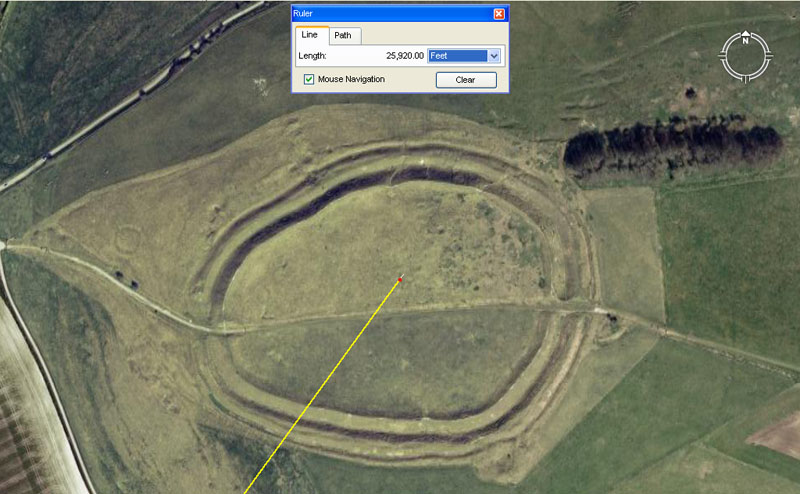
A vector comes in from the main obelisk position at the
centre of Avebury Henge's southern circle. This huge stone (found to be 21-feet
long when measured by Stukely in the 1700's) protruded high above the henge
walls and could be seen for miles around. The degree angle from its standing
position to the centre of Barbury hill crown is precisely 36-degrees. The return
angle back to Avebury is, therefore, 216-degrees.
Note: the ancient reed measurement was 126-inches
and the Greek foot was 12.6-inches. The ancient
British bushel capacity was 2160 cubic inches and
this was 1/10th of a Babylonian Homer volume
@ 21600 cubic inches. The sun spends 2160-years
in each House of the Zodiac during the cycle of Precession and the Moon is 2160-miles
in diameter.
It appears that the exact positioning of Avebury Henge's
huge obelisk and, indeed the position of the entire henge was co-dependant on
the position of Barbury Hill's crown position.
The preliminary evidence suggests that the Neolithic Age architects
and designers of Durrington Walls Henge found a suitable position aside the
Avon River, which also gave perfect North and East fixes onto prominent and
eternal landmarks. By this occurrence, calibrated surveying instruments could
first be set with high precision before secondary surveying positions (outlying
mounds, standing stones or post circles) were precisely placed in the regional
landscape at pre-designed distances and angles out from the centre of Durrington
Walls Henge.
THE SILBURY HILL TRIG
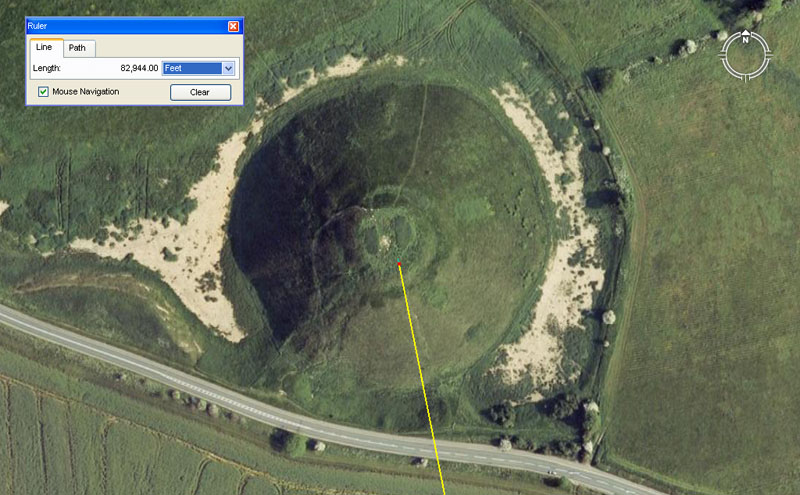
A dynamic surveying relationship exists between the epicentre
of Durrington Walls Henge and the top of Silbury Hill. The distance separating
these two surveying points was intended to convey 82944-feet
(as seen above on the Google Earth panel). With the equatorial size of the Earth
anciently set to the formula 12 X 12 X 12 X 12 X 1.2 = 24883.2-miles, the sum
of 8294.4-miles would constitute 1/3rd
of the distance around the Earth or 120-degrees of equatorial arc. This distance
being encoded between structures in Wiltshire, Southern England equates to 48000
of the largest Egyptian Royal Cubits @ 20.736-inches each. This increment of
length was positively identified by Sir William Flinders Petrie to be present
in the length of the coffer found in the Khafre Pyramid of Egypt. The coffer
measured 103.68-inches or 5 cubits of 20.736-inches each.
Depending upon which navigational system one was using
for positional plotting at sea, the above distance (82944-feet) would represent
the following fractions of the equatorial circumference of the Earth:
- Under the so-called "Greek" mile (5250-feet) system of
24883.2-miles, this distance between Durrington Walls Henge and Silbury Hill
would equate to 1/1575th of the distance
around the world. Note: A Greek mile = 1575-feet X 3.3333333.
- Under the "true"reading of 24883.2 miles of 5280-feet
(only 18.8-miles of shortfall), this distance would equate to 1/1584th
of the equatorial circumference. Note: A British standard mile = 1584-feet
X 3.3333333.
Alternatively, the return angle to the epicentre of Durrington
Walls Henge is 168.75-degrees and this value is dynamic lunar cycle and navigational
coding simultaneously. For example: A lunar year equates to 354.375-days or
21 periods of 16.875 days (405-hours).
The above amount of error in the coded or intended distance between
epicentres of the two Neolithic Age structures might equate to about 40-feet
in close to 153/4 miles. Any detectible error
in the coded degree angle is negligible. The prowess and accuracy of these ancient
surveyors is astonishing.
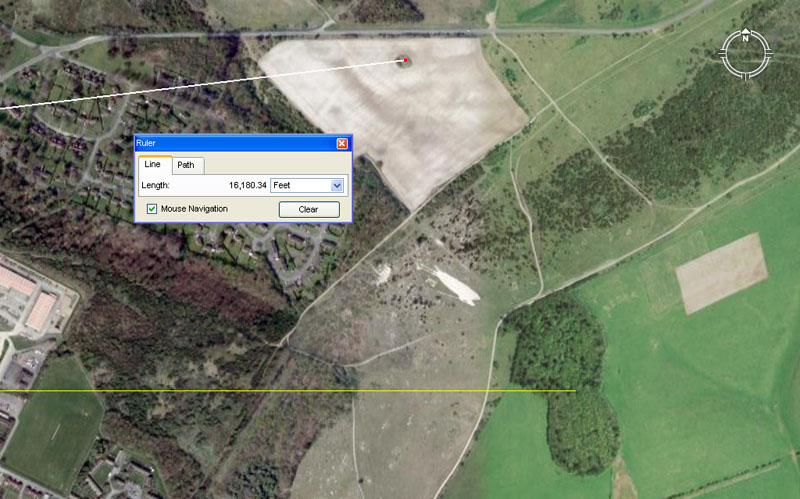
Similarly, while the ancient astronomer surveyors were
accurately configuring a line-of-sight position to represent due East @ 17010-feet
from the epicentre of Durrington Walls Henge, they also built a structure to
dually represent the PHI ratio (1.6180339 to 1), as well as another ratio attributable
to any 3,4,5 triangle. At the top of the picture a white line, extending out
from the epicentre of Durrington Walls Henge, resolves upon a purpose built
mound situated at a distance that was intended to mnemonically and measurably
code 16180.34-feet, at an angle around from North of 83.33333-degrees. In any
3,4,5 triangle, the shortest side will be 1.66666666 less in length than the
longest side. The sum of 1.66666666 is .83333333 X 2. Thus two very important
ratios, copiously used by ancient Caucasoid civilisations, are eternally preserved
in the position of this purpose built mound.
It is worthy to note that this mound would have been dual coded
and read, also, as 16200-feet (rounded PHI). The sum of 1.62 X 2 = 3.24 (another
essential factorable value in the ancient parcel of numbers. Remember, the due
East marker-mounds below this one sit 3.24 Greek miles out from the centre of
Durrington Walls Henge ... and were so erected in the English landscape from
about 2000-years before there was a Greek civilisation ... so who had the so-called
Greek measurement system first?
Alternatively, the very important value of 17010-feet built into
the dual-mound outlying position due East of Durrington Walls Henge, relates
to the Lunar Nutation cycle of 6804-days duration. The sum of 1701-days would
be 1/4th of the cycle.
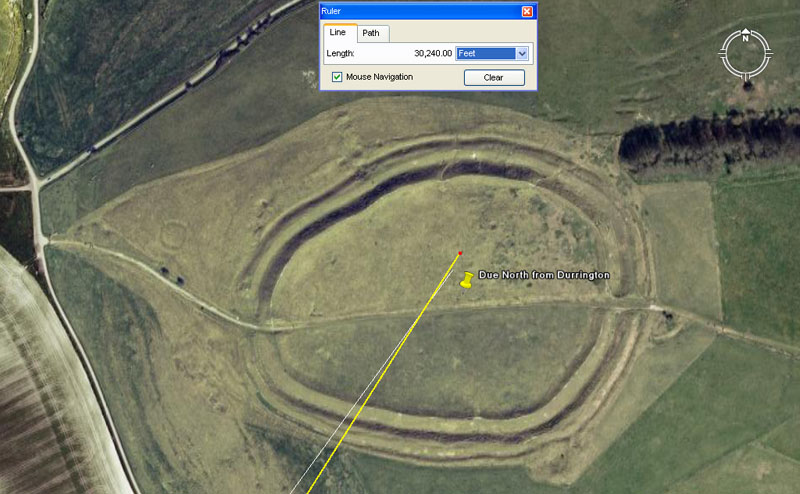
The degree angle from the centre top of Silbury Hill to
the centre of Barbury Hill crown is 32.36068-degrees or twice 16.18034. That
same distance between the two ancient trig markers was 30240-feet or 5-minutes
of equatorial arc for the world.
A yellow vector, originating on the top of Silbury Hill
is seen to resolve into the central region of Barbury Castle Hillfort (easily
seen from Silbury Hill), on the high Ridgeway. The angle (32.36068-degrees)
is pure PHI-based coding, whereas the distance is navigation-based. A white
line is seen to resolve into the centre crown area of Barbury Hill and this
originates at the main obelisk position at Avebury Henge. The distance is exactly
25920-feet (coding the duration, in years, of the Precession of the Equinoxes)
and the angle is 36-degrees (return angle 216-degrees).
The centre crown of Barbury Hill also represents "true" or "due"
North from the centre of Durrington Walls Henge, 20-miles to the South.
Yet another major station position that determined the epicentre
of Durrington Walls Henge was the centre of Stonehenge, 10368-feet distant,
with an accuracy of within 7-feet overall . This distance is 1 53/55th
British Standard Miles. The coded degree angle back from Stonehenge is 61.25-degrees,
a strong navigational code.
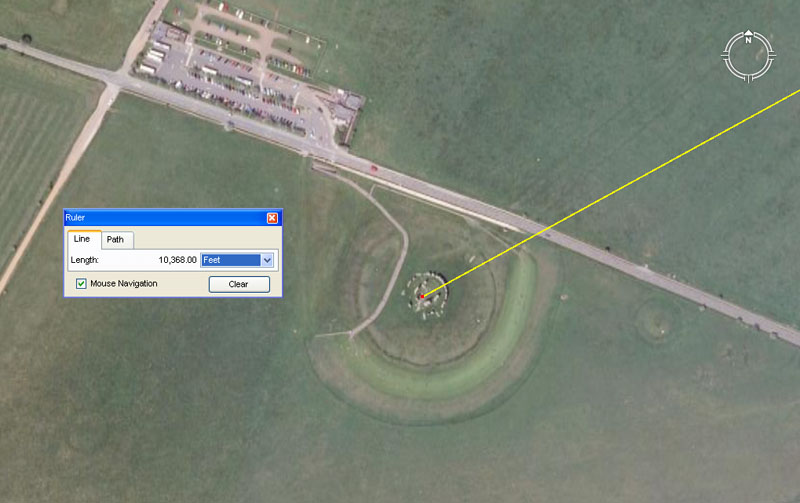
The coding contained within the ancient number 10368 relates
to the equatorial size of the Earth and also the speed at which the Earth rotates.
This is one of the most important values of antiquity, thus Stonehenge, as the
preeminent site standing off from Durrington Walls Henge was awarded the honour
of carrying this number.
So, where have we seen this number before?
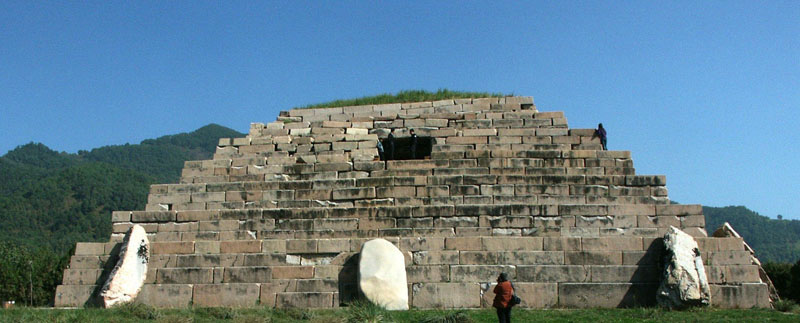
This very impressive stepped stone pyramid is called variously
the Gaogouli Pyramid or the Tomb of the General. It is situated to the North
of Korea at Ji'an, Jlin, China at coordinates Lat: 41.157650, Long: 126.226400.
This Chinese-Korean Pyramid is officially said to have a square
base measurement of 31.58 metres per side. It also has a series of obelisk stones
leaning against the base, the tallest of which has been measured at 4.5 metres
.X 2.7 metres. The pyramid's square base is offset from the cardinal points
of the compass and its eastern side appears to orientate towards north at an
intended azimuth angle of 314.16-degrees (coding PI @ 3.1416).
The measurement standard by which it was built is recognisable
within the factorable number system and universal measurement standards used
by the Caucasian cousin nations since remote antiquity and up until modern times.
Consider the following:
1. The base length of 31.58 metres easily converts
to 103.68' (10317/25ths)
or 1244.16" (12444/25ths).
2. This length is equivalent to 60 of the largest
of the Egyptian Royal Cubits @ 1.728' (20.736" ... 2092125ths).
Sir William Flinders Petrie identified usage of this particular cubit in his
measurement of the coffer in the Khafre Pyramid, wherein it was 5 of these cubits
long or 103.68-inches. Note: A cubic foot (12 X 12 X 12 inches) = 1728 cubic
inches. Also the base circumference of Silbury Hill in England is 1728', based
upon a diameter of 550'.
3. The "Cab" volume,within the Jerusalem
liquid volume standard was 103.68 cubic inches.
4. The "Stirling Jug" standard capacity
volume of Scotland was 103.68 cubic inches.
SO WHAT IS THIS BASE LENGTH CODING?
It is coding the equatorial size of the
Earth and principles related to navigation across the vast, featureless oceans
of the world. It is also coding the speed at which the Earth rotates each hour,
which leads to an understanding of an accurate chronology system for measuring
the daily passage of time. Here's how it works:
1. The ancient way of reckoning
and remembering the equatorial size of the Earth was 12 X 12 X 12 X 12 X 1.2-miles
or 24883.2-miles. The half value of 24883.2 is 12441.6 or ten times the inch
value generated on any one side of this pyramid.
2. If one circumnavigates
the pyramid @ 103.68-feet per side , then the distance covered is 414.72' (41418/25ths).
If this value were read symbolically as "miles" then that distance
would by 1/60th of the equatorial circumference
or 6° of arc.
3. With the Earth considered
to be 24883.2-miles in circumference its rate of speed in miles per hour is
24883.2 ÷ 24 hours = 1036.8 MPH.
4. The half value of 103.68*
is 51.84 (5121/25ths)
and the slope angle on the Great Pyramid of Egypt is 51.84° . The Great
Pyramid @ 756' long is 72 Hebrew reeds in length. It therefore covers an area
of 72 X 72 reeds or 5184. Alternatively, the sum of 51.84-years is 1/500th
of the 25920-year duration of the Precession of the Equinoxes.
5. The azimuth angle that
the Octagon of Newark Ohio, USA (a very sophisticated and large geometric earthmound
complex) lies on is 51.84° .
6. When
navigating at sea using the ancient British league of 16500' (3.125-miles of
5280') for linear legs of distance covered, the plotting circle generated per
league was 51840'. This plotting circle was then fully divisible by 360°
and as long as legs of straight line travel were done in accumulations of full
leagues or lesser divisions thereof before a heading change, then accurate calculations
related to positions at sea were easily facilitated. By this mathematical method
the navigator could always keep track of the angle back to the point of departure
or onwards to the destination.
It seems apparent that the height of the
base tier of this pyramid was intended to represent 10.368' or 124.416",
which again would act as a mnemonic device for remembering the equatorial circumference
of the Earth and the speed of its rotation.
This pyramid, situated on the route from
Western Europe to the Bering Strait and the Americas, is said to be thousands
of years younger than the monuments at and around the Durrington Walls-Stonehenge
complex.
Continue









